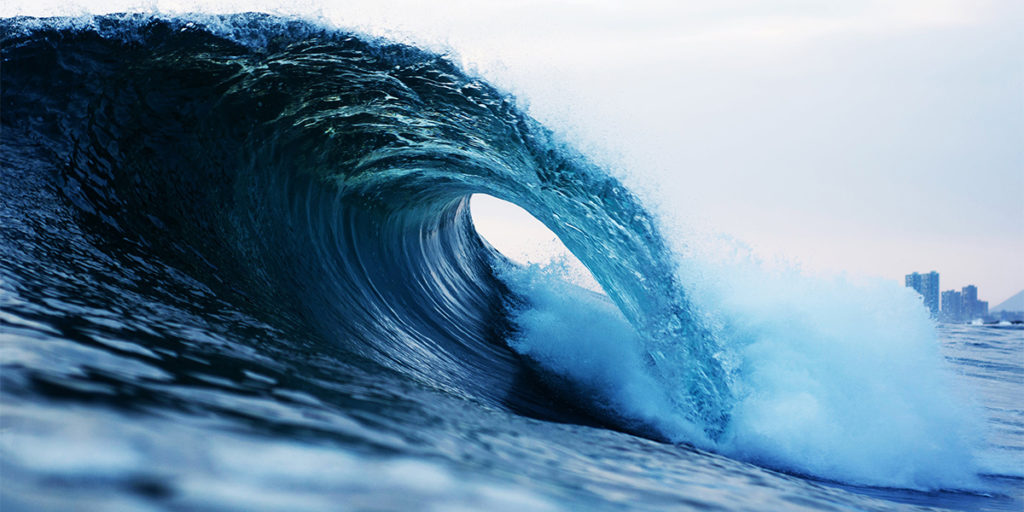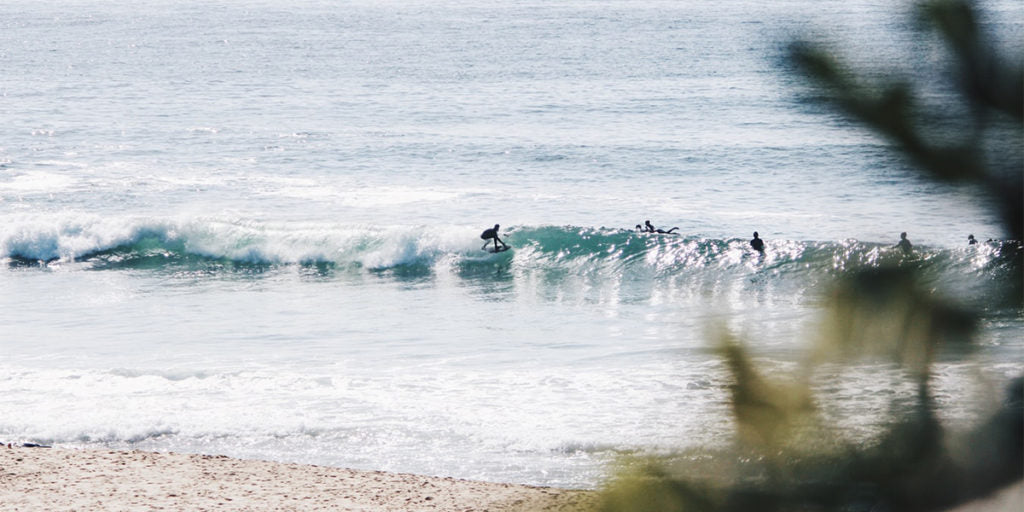



Posted on August 21, 2019 by Doug Robichaud
Before you begin to learn how to surf, you first need to figure out your surfing stance. Are you a regular or goofy footed surfer? Both of these stances are used by beginners and pro surfers alike when riding a wave.
Your surfing stance determines which foot is in front of the other when you stand-up on your surfboard. Regular footed surfers ride waves with their left foot forward, and goofy footed surfers ride waves with their right foot forward. Keep in mind, there is no right or wrong surfing stance. Choosing between a regular and goofy stance all comes down to which one you feel more comfortable with.

Repeat after me, "no surfing stance is better than the other." Regular footed surfers are no better at surfing than their goofy counterparts, and vice-versa.
To give you some perspective, over the history of surfing there have been regular and goofy stanced surfers who have been coined world champions. For instance, Kelly Slater is a world champion regular footer and legendary surfer Tom Curren is a world champion goofy footer.
The easiest way to figure out if you’re a regular or goofy footed surfer is to identify your dominant foot. When standing on a surfboard, your dominant foot is usually the foot placed behind the front foot (closer to the tail of a surfboard).
To give you an idea, most right-handed people have a right dominant foot, and most left-handed people have a left dominant foot. This is why most right-handed people have a regular surfing stance and most left-handed people have a goofy surfing stance. However, this isn’t always the case. Some right-handed people prefer surfing goofy while some left-handed people prefer surfing regular. Remember, it’s all about which stance you’re most comfortable with.
Below, there are five simple tests you can try at home to confirm your stance. I recommend you try all five tests to make sure your stance stays consistent. To make your life easier, I’ve included a simple definition for both regular and goofy stances below to reference.
Regular stance: Left foot forward, right foot back
Goofy stance: Right foot forward, left foot back

The best test for determining whether your surfing stance is regular or goofy is to run and jump as high as you possibly can off one leg. Which leg did you choose to jump from? If you chose to jump from your right leg, that means your right foot is dominant and your surfing stance is most likely regular. If you chose to jump from your left leg, then your surfing stance is most likely goofy. I write ‘most likely’ because this test might not apply to everyone. A small percentage of people could jump with their right foot but still prefer riding goofy.
Approach a set of stairs at a normal walking pace. Which foot did you choose to place on the first stair? If you stepped on the first stair with your right foot, then you’re most likely regular footed. If you stepped with your left foot first, then you’re most likely goofy footed. Try walking up the same staircase a few times in a row to see if you continue to step with the same foot first.
Stand-up straight with your feet together and slowly lean forward. Continue leaning until you start to fall. The foot you used to catch yourself from falling is probably your dominant foot. If you caught yourself with your right foot then you’re most likely a regular footed surfer. If you caught yourself with your left foot then you’re most likely a goofy footed surfer.
Skateboarders and snowboarders also use regular and goofy as riding stances. If you already enjoy either of these two sports, you probably already know your stance. Your stance will rarely change between any board sports. However, if you've never tried skateboarding or snowboarding, grab a friend’s skateboard and have them lightly push you on it. This will allow you to feel out each surfing stance and will help you easily determine which one feels the most comfortable and stable.
Similar to a skateboard, an easy way to identify your surfing stance is to stand on a surfboard on a flat surface. Try out both regular and goofy stances. Usually, standing on a motionless surfboard will give you a clear answer to which surfing stance you will feel more comfortable adopting. Make sure you remove your fins before standing on your board if you're not on the sand. Otherwise, you'll damage your fins and possibly your surfboard.

Once you’ve figured out if you’re regular or goofy, you can learn how to surf in the ocean. Stick with the stance you’re most comfortable with and you will be able to learn the basic techniques of surfing much quicker.
Now that you've determined your surfing stance, it’s time to go over the surfing terms frontside and backside. Frontside and backside are two terms that relate to the direction your body faces when riding a wave.
Frontside: When a surfer’s chest and toes are facing the wave. Regular footed surfers ride frontside on waves that are breaking to their right; they ride backside on waves that are breaking to their left.
Backside: When a surfer’s back and heels are facing the wave. Goofy footed surfers ride frontside on waves that are breaking to their left; they ride backside on waves that are breaking to their right.
Generally, surfers favor surfing frontside over backside because it feels more natural when going down the line. Because of this, learning how to surf backside will be more difficult at first. However, once you advance as a surfer and learn how to shred waves frontside and backside, you might not favor one over the other. You might even start preferring surfing backside over frontside...

Since most surfers favor surfing frontside, regular and goofy footers tend to choose surf breaks that offer the best waves for their stance. Before I explain the best surf breaks for your stance, it’s important that you know the difference between a beach break and a point break.
Beach breaks: Where waves break over a sandy bottom. These are generally known as the big sandy beaches that people hang out on during the summer season. The quality of waves will vary per beach break. They can either provide extremely powerful and hollow surf, or gentle and slow surf, depending on the location and how the sand bars have formed over time.
Point break: Where the waves form off a point and break along a stretch of land. This type of break usually has a reef or rocky bottom. Many surfers love surfing point breaks because they offer longer more 'rippable' waves with more consistency than beach breaks.
Point breaks are classified as either a right-hand point break or a left-hand point break. A right-hand point break means the waves at this point mainly break right. A left-hand point break means the waves mainly break left. This is why regular stance surfers love surfing at right-hand point breaks and goofy stance surfers love surfing at left-hand point breaks.

The best surf break for regular footed surfers is a right-hand point break and the best surf break for goofy footed surfers a is a left-hand point break. This allows regular footers and goofy footers to exclusively surf frontside on every wave. No matter which stance you ride, point breaks will be a great spot for you to learn how to surf when the waves are small. Keep in mind, some popular point breaks tend to have a localized crowd, so be courteous and follow the proper surf etiquette when you’re out in the lineup.
Beach breaks are also an excellent option for both regular and goofy footed surfers. Usually, the atmosphere at beach breaks is a bit friendlier and will give you the option to surf frontside or backside. This would be a good time to practice your backside surfing.
The difference between regular and goofy footed surfers comes down to where you prefer your feet to be placed on your surfboard while surfing a wave. A regular footed surfer stands on a surfboard with their left foot forward and right foot toward the back. A goofy-footed surfer stands on a surfboard with their right foot forward and left foot toward the back. To determine your perfect surfing stance, you can try out a series of tests to identify your dominant foot or to see which stance offers you the most comfort and stability.
Now get out there, paddle out, and put your feet to the test.

Sign up for our newsletter
Get exclusive insider access to products and promotions
Copyright © 2024 Paddle Boards and Surfboards By ISLE Surf & SUP. All Rights Reserved